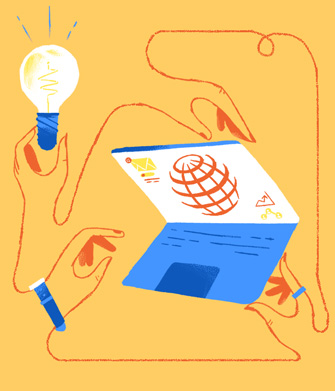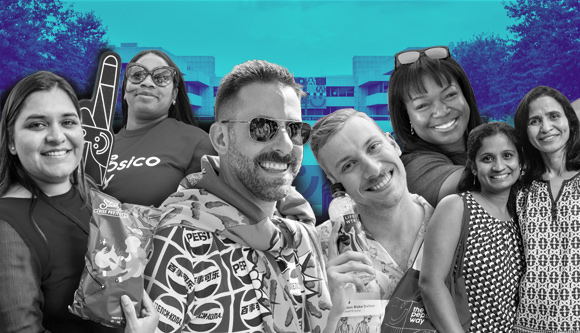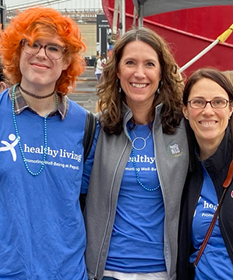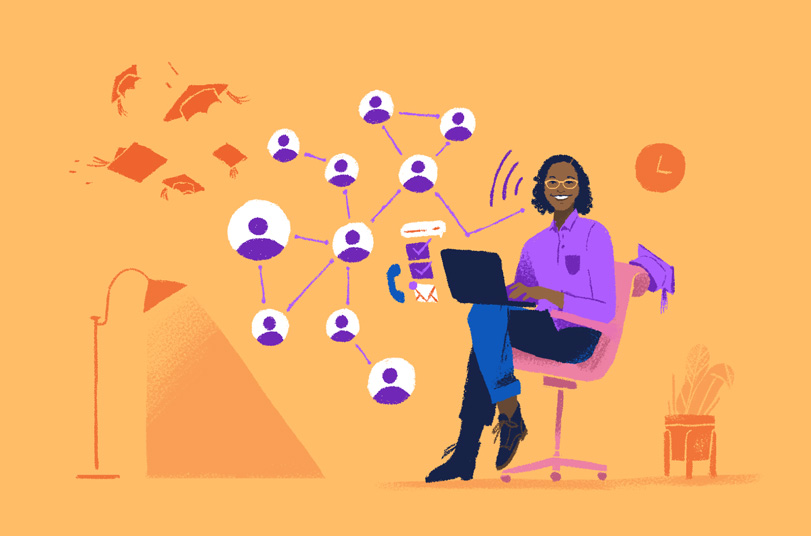
You started as an intern. What initially attracted you to PepsiCo?
When I was a junior in college, I attended a career event that was co-hosted by my university’s chapter of the Society of Women Engineers, which I was president of at the time. I wasn’t necessarily looking for an internship, just helping out with the event. But I started casually chatting with a PepsiCo IT recruiter, and we instantly connected. It was the culture of PepsiCo that stood out to me most. Even just in the internship, it seemed like the company really invested in their people and made an effort to champion their growth and celebrate success. So I gave the recruiter my resume, and I was selected to be an intern.
How did your internship lead you to a full-time career at PepsiCo?
We know how to work hard, and we know how to have fun, and as an intern that became very apparent to me. We had kickball games and then we would meet with senior leaders in a speed-networking-type setting. I got to meet so many wonderful people and had really inspiring mentors. They would take me out to lunch and give me advice on how to navigate PepsiCo and how to kick off my career here. One of those mentors told me about the Frito-Lay Go-To-Market space and how they were developing applications to support the program. And that just really fascinated me, that IT had a direct impact on the front-line business. So after my internship, I started full time with the Frito-Lay Go-To-Market team, working with the sales team in the field.
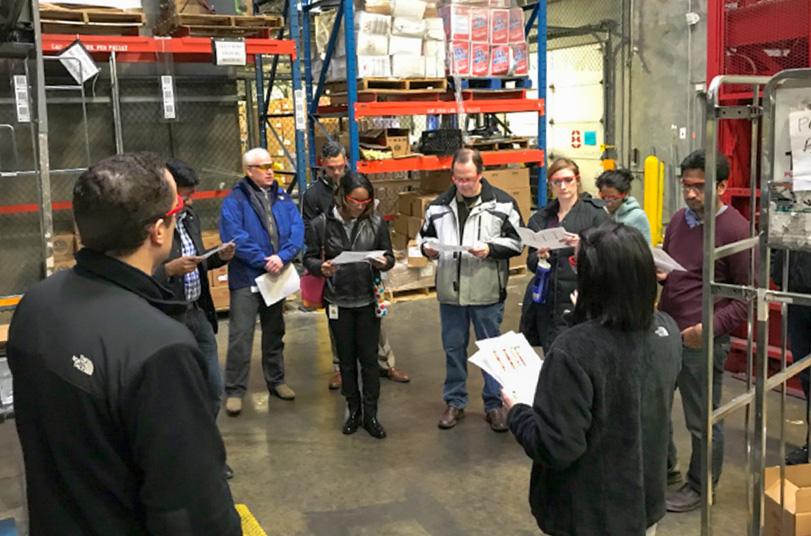
Mayaria and her team met at distribution centers to learn about the picking and shipping processes.
Every day you’re collaborating across departments. Did you expect your career in tech to be so people-centric?
Definitely not. When I got my computer science degree, I always thought my career path was limited to a developer. But since I have been with PepsiCo, I have seen that being a developer is just a springboard into other tech opportunities. Tech here is not just coding, it’s strategy, project management, data and analytics, security, infrastructure, all of these things that people will probably never think about outside of computer programming. There are really no limits to tech at PepsiCo.
What is the best part of working in tech at PepsiCo?
The flexibility and the diversity of the field. In my first role I was focused on coding and developing programs. In my next role I was configuring platforms, like Salesforce, for out-of-the-box capabilities. Then I was working on data analysis, identifying insights. And recently I transitioned to my role as a Change Leader. I’ve gone from very technical to more strategic, but it’s all been tech-focused, and that doesn’t happen in every company.
Plus, I enjoy being able to work side by side with such talented and skilled individuals and soaking up all the knowledge and experience they’ve gained over the years. They encourage me and challenge me in ways I couldn’t challenge myself.
“Coding, strategy, security and analytics, there are so many different types of tech at PepsiCo.
Mayaria Johnson,
Global IT Change Enablement Lead
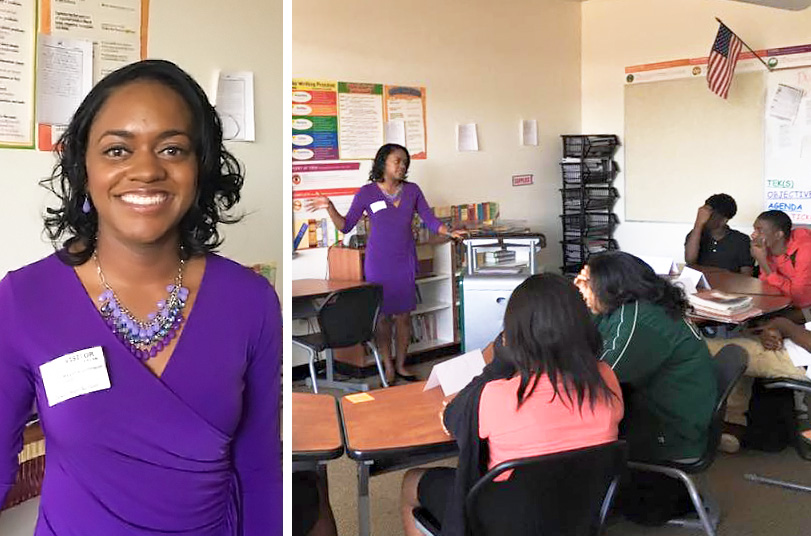
Mayaria spoke to her mother’s class about her career path with PepsiCo and how she got to where she is today.
You are very involved in your community, volunteering both at work and outside of work. Why is that community engagement important to you?
My mother teaches at a high school, and I’ve talked to her class several times about my college to career journey. I always love doing that, because I’ve found that a lot of people in my community don’t always feel that they can accomplish certain things. But I like to tell them how I stayed focused and motivated, how I was supported, and how I overcame some of the same challenges they are facing now. Sharing those nuggets of information hopefully allows them to see that they can do it too.
At PepsiCo, I had the opportunity to mentor an intern, and coach a group of interns who were working on a business challenge. Being able to share what I’ve learned along the way, like so many others have done with me, is really rewarding.
Marilyn Colantuoni
Title: IT Latin America Strategy, Portfolio & Transformation Director
Location: Mexico City, Mexico
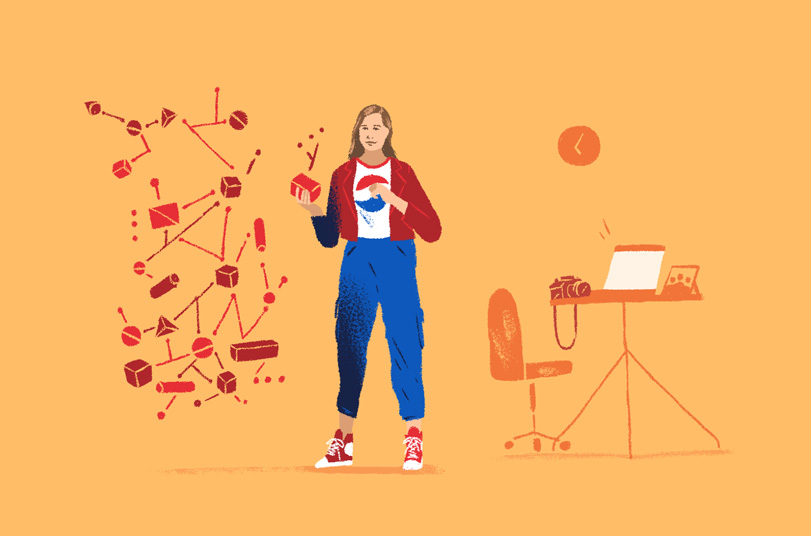
You’ve been at PepsiCo for over 10 years. What first brought you to PepsiCo?
Since I was a little girl, and people would ask Coca-Cola or Pepsi?, I would say Pepsi! I’ve always had an inclination, a connection with PepsiCo — the branding, the products, everything. But it really wasn’t until I was called to interview with PepsiCo that I understood all that it does. It’s so much more than a food and beverage company, and the people who work here are incredible. It lived up to my childhood love, and I wanted to work at a place that felt magical.
You have a long history of working in tech. How is tech at PepsiCo different from other companies?
Yes, I’ve always worked in tech, and never has my job had such a tangible impact on the end consumer. Our brands and products have a connection with real people, their day-to-day lives, their homes, their families. And through technology we are able to think about innovative things that will impact people in a very human way.
“I’ve always worked in tech, but when I came to PepsiCo I finally had a connection to the consumer on a personal level.
Marilyn Colantuoni,
IT Latin America Strategy, Portfolio & Transformation Director
As an IT strategist, what do your days look like?
We’re always analyzing. Dissecting projects, looking for areas of improvement, trying to find more efficient and agile ways of doing things. And not just for IT, but for the entire organization. If you don’t know the business and where we’re headed, you’re going to miss the mark on those efficiencies. So a large part of my role is also understanding other roles to ensure that our analyses are accurate.
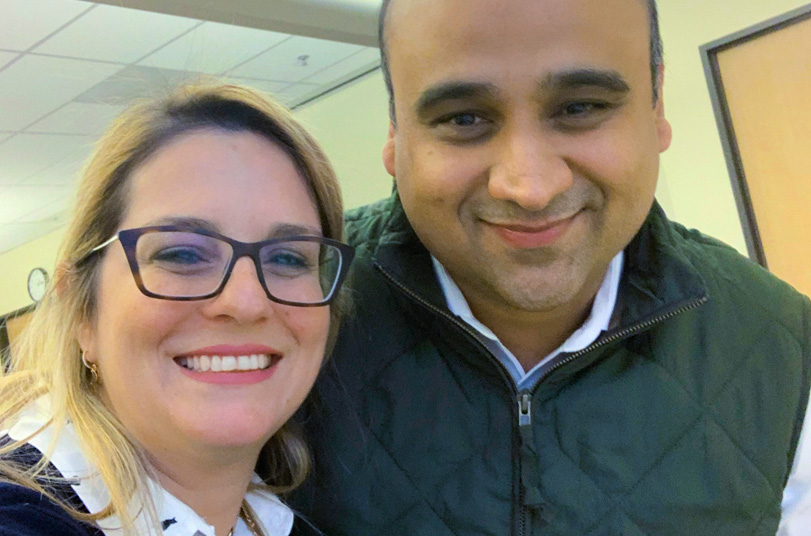
Marilyn and her manager, Yogesh Garde, in the Dallas office.
You won “Best of IT 2016 Award Bright Idea for Productivity.” Can you tell us about your project?
When I was a manager, I found that we were often unable to make the investments needed to maintain our IT department. Things like updating software, laptops, desktops, servers and handhelds. And if your equipment isn’t working, you’re losing time and money. Well, Mexico and Colombia were going through some changes, so with this initiative, we brought more than 2,000 devices that were in great condition to Venezuela, reused them and saved close to two million dollars.
What do you like most about working in the Latin American market?
There are about 30 different markets that I get to collaborate with, and I love it. Everyone is so open and respectful; we have a very collaborative spirit. I was in Caracas for over 10 years, and the office there is pretty spectacular. There are plenty of open spaces, lots of murals, art and natural light.
I also love photography — and Latin America is so picturesque. I take pictures of the city, the beach, everywhere I go. For me, every photo has a meaning as it captures a special moment in time.
Did you know?
PepsiCo was named one of Fast Company’s Best Workplaces for Innovators in 2020.
Austin French
Title: Manager, Release Train Engineer
Location: Plano, Texas
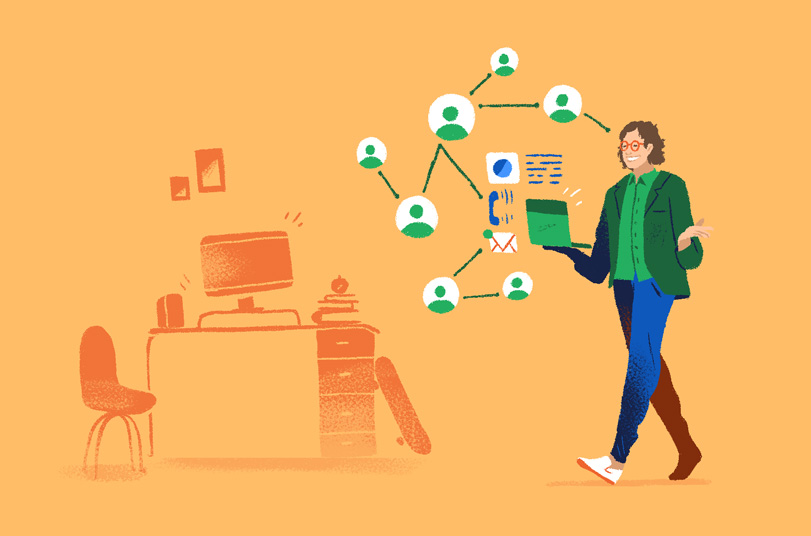
You started as an intern. What was it about that experience that made you want to join PepsiCo full time?
I noticed there were a lot of people that had been with the organization for decades. So I felt like if PepsiCo can take care of someone well enough that they would spend a significant portion of their life working here, then maybe there’s something here for me as well.
As a tech person working closely with the business side of PepsiCo, what have some of your roles looked like?
In my first couple of positions, as a business relationship manager, I would take feedback directly from the customer and relay it back to the working teams that are actually developing the product to create a better result.
Then I got more involved in the technical side of the IT department as a scrum master. My whole job there was to remove any barriers for the technology experts — the hands-on keyboard team building the application — to ensure that they could do their job without any problems.
Now I’m doing that at scale, ensuring that 15 different teams are all working toward the same solution. You can imagine it like an engine and each team represents an individual component. I’m ensuring everything runs smoothly across all those different teams so we can maintain our commitment to our business partners.
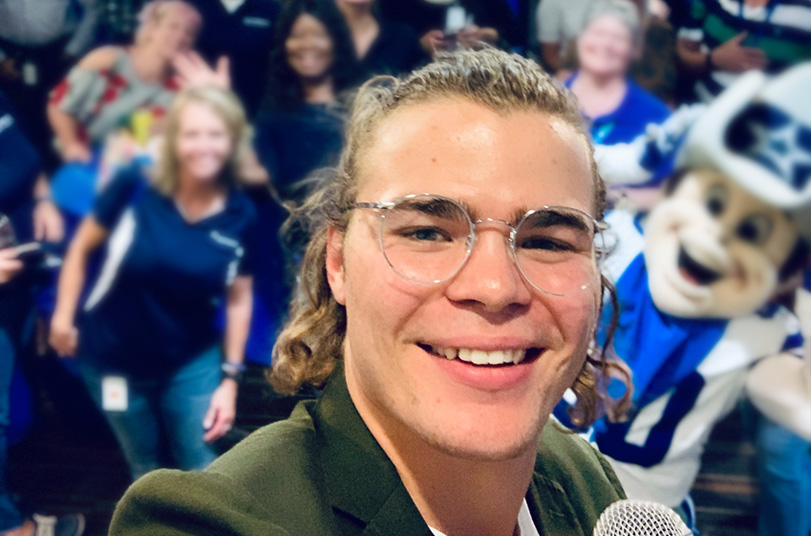
Austin French jumping in for a big group selfie at a Global IT Activation Event in Plano HQ.
What product are you working on now with all these teams?
On the Frontline, Frito-Lay Sales employees use a custom-built handheld device to service our customers, like Walmart and Kroger, to execute activities like selling, ordering and managing our supply chain. Well, soon those handheld devices will be out of date as we scale our systems to work with 5G. Our job is to replace the handheld devices with smart devices and develop an application infrastructure on the back end that connects back to our Enterprise Resource Planning system. It’s no small feat. It’s very much a team effort.
How important is tech at PepsiCo?
Very. We have really strong leadership in both IT and the business who collaborate to integrate. The firm partnership between departments is really one of our key differentiators. It also continues to surprise me how knowledgeable some of our “nontechnology” employees are about the technological advancements that are happening in the world.
“We’re seeing a big emphasis on leveraging technology and integrating IT with the business.
Austin French,
Manager Release Train Engineer
What innovation do you think tech will bring to the food and beverage industry?
Technologies like blockchain will make things like ingredient traceability, a reality. For example, if we find out that there was maybe a defect of the ingredients, we could use blockchain to figure out exactly which packages to pull off the shelf, instead of pulling everything. That will also have an impact on our customer relationships too. When we have a very clean line of traceability, we can articulate exactly to the customer what happened, be very transparent, and build trust.
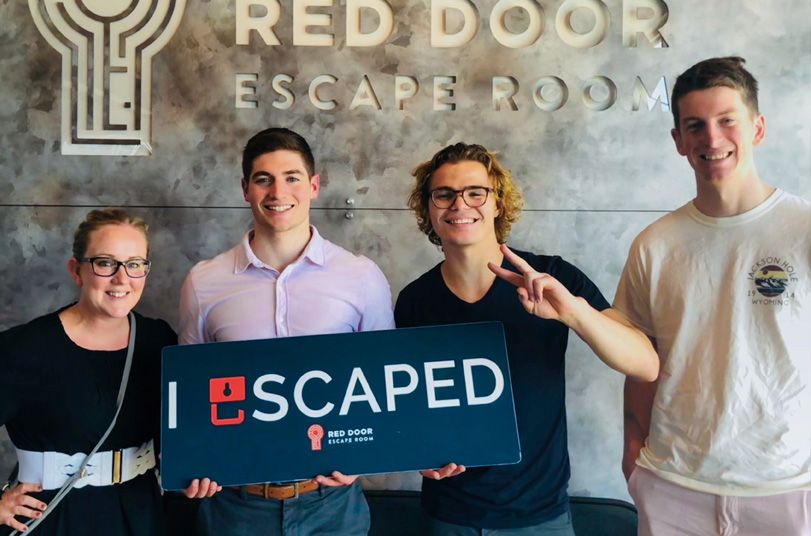
As a new hire, French and his new PepsiCo team bonded and collaborated at an escape room experience.
A lot of PepsiCo tech is based in Plano, Texas — what do you like about that location?
If you can’t tell by the surfer style hair, I’m a huge skateboarder. And Plano has awesome, beautiful skate parks.
I play music — guitar and piano — and I have to say, the live music scene here is amazing. There’s an organization called Sofar Sounds, they put on great local shows. So anytime I can get connected to that and learn from other artists is an amazing opportunity.
And to wrap it all up, the museum scene here is top-notch. Whether you’re more into natural history or into modern art, sculpture art, there’s the Nasher Sculpture Center, the Dallas Museum of Art, the Kimbell Art Museum over in Fort Worth.
Prakash Patil
Title: Associate Director of Advanced Analytics
Location: Hyderabad, India
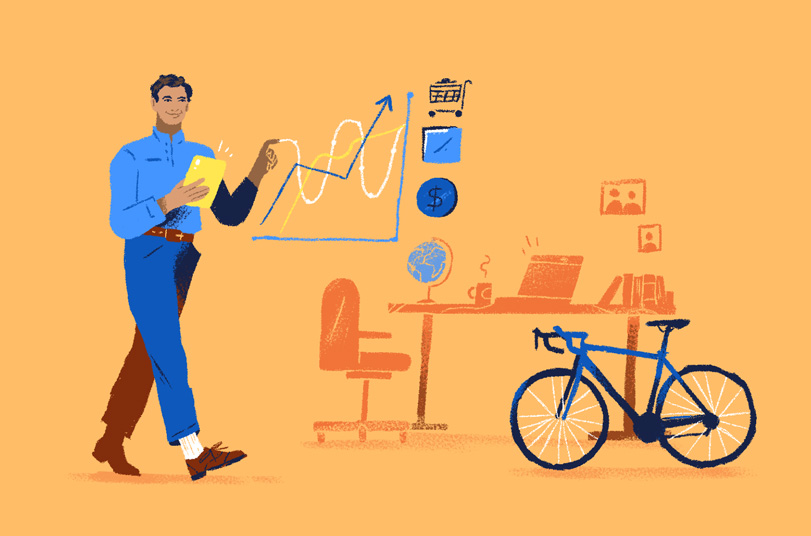
How did you first get interested in tech?
Actually my major in university was construction, and my master’s was a combination of IT project management and construction technology. Through those programs I ended up using a lot of advanced design software and a bit of HTML. And during my master’s project I really discovered my passion for software coding and technology. For the last 18 years, I’ve been working with IT application development, data development, business intelligence and advanced analytics.
What was it about PepsiCo that made you want to join the tech team here?
I asked some very specific questions during my interview. Advanced analytics is something that has always fascinated me, and it’s one of my strengths at this point in my career, so I wanted to know how advanced PepsiCo’s tech was. And I was quite happy to find out that PepsiCo was already implementing a lot of advanced analytic models, whereas most organizations are still trying to test the waters with these models. PepsiCo’s acceptance and adoption of the latest tools was very telling to me. It was my driving factor to join.
What are some examples of those advanced programs?
In analytics, for example, PepsiCo is already adopting ML Ops, or machine learning models, to integrate development and operations functions of our programs, making us faster in terms of our time to market. And on the business intelligence side, we are working on the latest tools, Power BI or Tableau. These are some of the best programs in the market, and the adoption of these tools far advanced in PepsiCo.
How is working in tech at PepsiCo different from other companies you’ve worked at?
The data team and analytics team sit in the same organization, which wasn’t the case in my earlier organizations. There was always a struggle in terms of collaboration between these two teams because they had different priorities. But with any work you do on analytics, data is the backbone, so that collaboration is key. At PepsiCo, these teams are in the same organization which allows us to work toward a common goal and get things done faster.
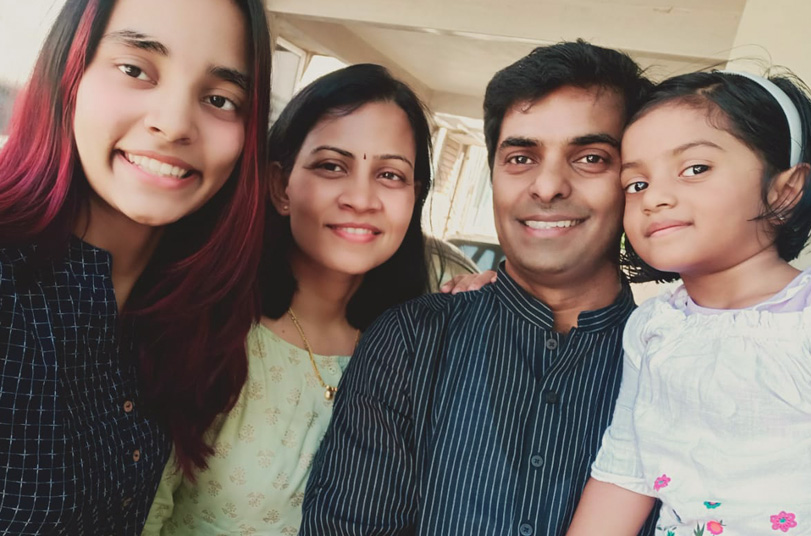
Prakash Patil and his family explored the cuisine and culture of Hyderabad.
What role does analytics play in PepsiCo as a whole?
PepsiCo is a CPG organization, whose partnerships with major retailers are key. There are several functions where analytics can be applied, whether we are tracking our performance through different operational KPIs or using historical data to make our future predictions. In supply chain, for example, we can help predict future risks by analyzing customer data and spotting patterns. And in revenue management we can see how even a slight tweak to price and promotion can make a huge impact on sales.
As associate director of advanced analytics, what do your days look like?
Fifty percent of my time goes to projects where we are really looking into the different problem statements, execution and development of our models. And that’s for several sectors — Asia, Middle East, South Africa, North America, Mexico and Europe. Then the rest is split between architecture and platform decisions, people development, career conversations and initiatives like talent building.

Every year Patil takes part in running and cycling events throughout the city.
You’ve been at PepsiCo for a little less than a year. What has been one of the most surprising things about the tech at PepsiCo?
I think the first thing that has really impressed me is how people act as owners. There are some bold decisions being made at every level, and people are ready to experiment and take risks. We are implementing new tools to increase our capabilities and efficiencies, and they may present some initial challenges, but we fail fast and move forward.
I would tell anybody who’s looking to join PepsiCo, the learning is two to three times faster than any other place I’ve worked. You’re pitched against so many new factors that you may not have experienced before. You’ll constantly be exposed to new ideas and learn continuously.
“The culture at PepsiCo is fail fast and learn faster.
Prakash Patil,
Associate Director of Advanced Analytics
Hyderabad, India plays a large role in tech at PepsiCo. What are some of your favorite things about living in the city?
Hyderabad has a history; it’s called the city of Nawab. Nawab was an emperor who ruled the city way back, and he had a lot of monuments built here that you can still go see today. The Salar Jung Museum is full of his antiques, and his Golconda Fort still stands today. And it’s a great city for running. My wife and I participate in a lot of races here, and they close down certain routes so the runners can go right through the streets.




